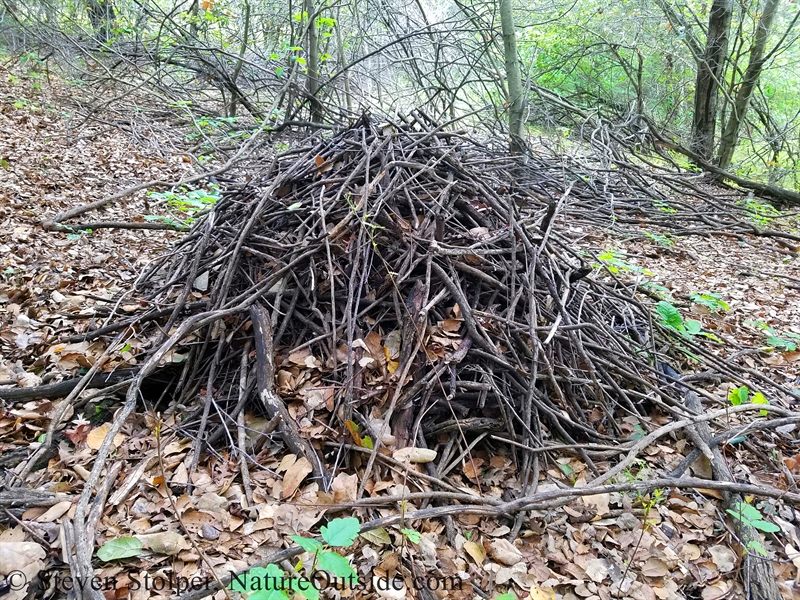
It’s funny how many hikers stroll through nature without any understanding of it.
They get exercise, but miss the essence of the forest.
Many times I’ve seen a once-in-a-lifetime event unfold just feet from an oblivious hiker. It’s not that he is incapable of seeing. He just doesn’t understand what’s happening in front of him.
And it’s a shame. If we open our minds to nature we’d be astonished by the magical moments we’d witness. When you make an effort to understand nature, every step into the wild leads you closer to hidden beauty.
This article contains affiliate links…
Mystery Shacks
Here’s a prime example. While hiking recently, I came upon this structure in the forest:
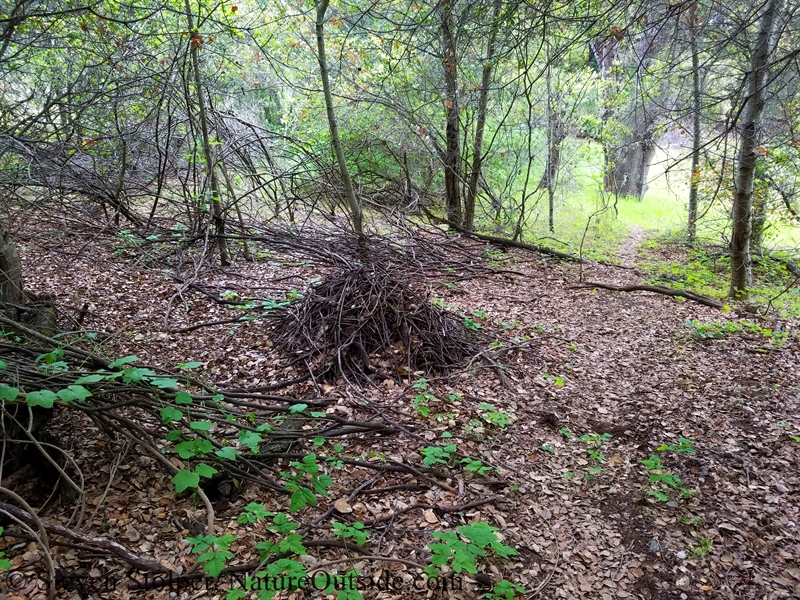
What is this pile of sticks beside a game trail? Did a human make it? Is it a random pile of sticks?
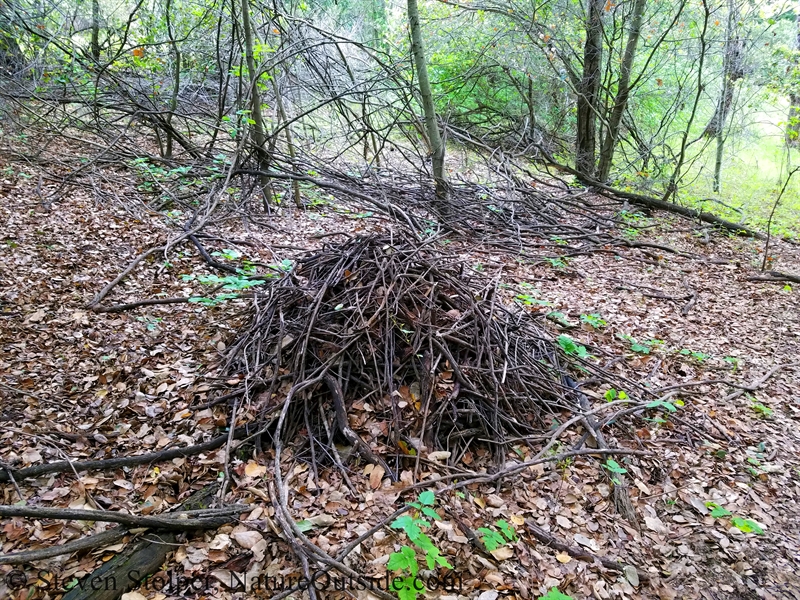
Here’s a hint: It is not a random pile of sticks. It is a house!
Do you know what it is? If you hike in California, it is hard not to see these. But hikers rarely notice them, or they mistake them for random debris piles. But there is nothing random about this pile of sticks. This one is unusual only because it is free standing so prominently beside a game trail.
Meet the Builder
This is the home of a Dusky-footed Woodrat! In this case, the builder is a San Francisco Dusky-footed Woodrat (Neotoma fuscipes ssp. annectens).
Woodrats occur throughout the US except for the northeast and Alaska. You tend to find them in warmer and dryer climates. Dusky-footed woodrats mainly inhabit California and western Oregon. The ones near me prefer the mixed oak forest of the Santa Cruz Mountains.
Woodrats are sometimes called “packrats” because they incorporate objects they find into the structure of their nests. This can include tennis balls, eyeglasses, ball-point pens and other human detritus. Woodrat nests near cabins have been found to contain silverware, dentures, boots, and even blasting caps.
Although they’re called “rats”, they are much larger than the Norway Rats in my old neighborhood. Dusky-footed woodrats can be 16-18 inches long (including tail). And the ones I’ve seen have been quite portly.
They have cinnamon and charcoal color fur. But all the woodrats I’ve seen near me have sooty charcoal-colored fur without trace of the cinnamon color.
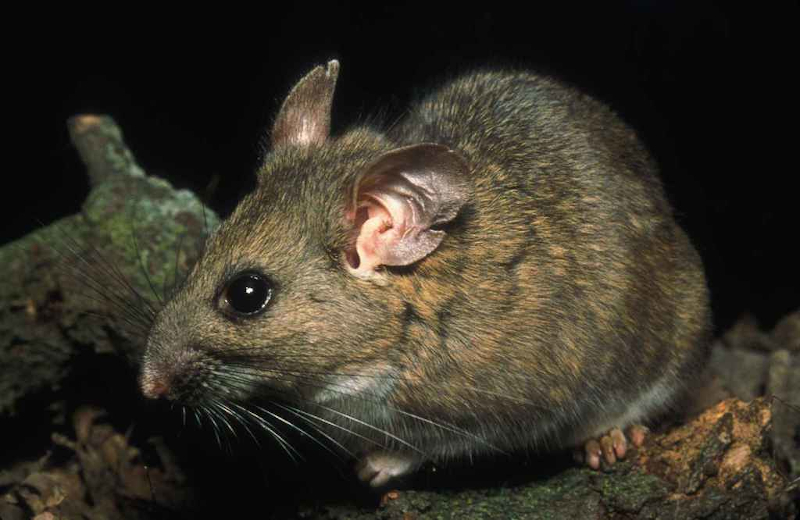
Dusky-footed Woodrat.
(Photo by Peterson B Moose, U.S. Fish and Wildlife Service)
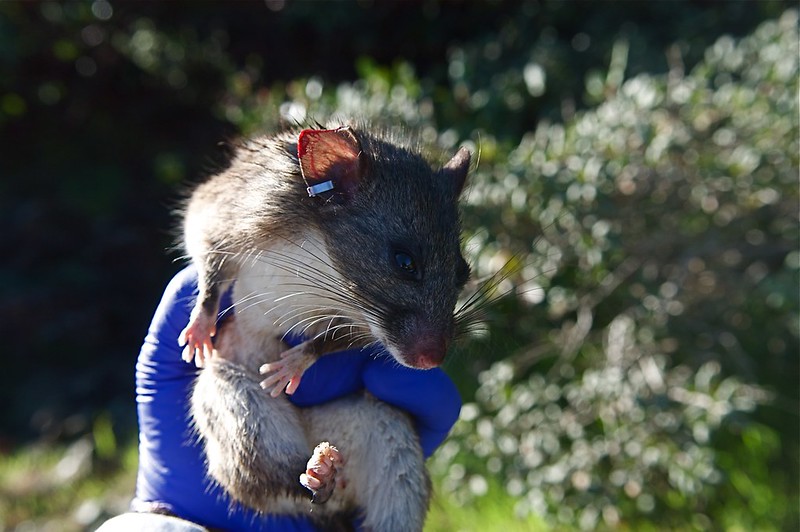
The Dusky-footed Woodrat is large.
(iNaturalist Photo 26784, (c) Matt MacManes, some rights reserved (CC BY-NC-SA)
Why We Rarely See Them
Dusky-footed Woodrats are mainly nocturnal, leaving their nests 30 minutes before darkness and foraging until 30 minutes before sunrise. But occasionally I see them during the day.
They’re good climbers, and like to live where there are plenty of trees. The woodrats can use many nests simultaneously, and spend their entire lives in the vicinity of them.
As you would expect, most animals that prey on woodrats are nocturnal. Great horned owl, spotted skunk, weasel, fox, bobcat, coyote, badger, raccoon, and snakes feed on them. If a woodrat strays out into the daylight, it can become food for hawks.
And before Europeans arrived in California, Ohlone peoples roasted woodrats for a snack by setting fire to their nests. Its remains are noted in Ohlone shell middens.
When it comes to food, woodrats are generalists. But they specialize depending on the environment they live in. The Dusky-footed Woodrats near me specialize in oak acorns. But woodrats will eat tree nuts, leafy vegetation, inner bark, seeds, and fruits.
Woodrats can cache between 25 and 271 days of food in their nests. They consume the food in order, based on perishability. Females will sometimes cache bones for calcium.
Woodrats generally don’t need open water to drink. Their plant-based diet supplies them with the water they need.
Woodrats are not “bro-dents.” They are individualistic and territorial. Really they’re antisocial, except during mating season. Females raise the young alone and have between 1 – 5 pups. They leave the nest at about 3 months and reach adult size at 8 months.
It’s a Rat-ical Structure
It’s quite common to see Woodrat nests hiking in California’s Santa Cruz Mountains. Often it’s built around a tree trunk for structure and looks like a naturally occurring debris pile. But I’ve also seen them high in trees and on the dashboards of cars long abandoned in the forest. The nest I found and photographed is a rarity in my experience – a freestanding nest.
Dusky-footed Woodrat nests can be as wide as 8 feet in diameter and 5 feet high. The rats construct them mainly from sticks and twigs. They carry smaller ones in their mouths and drag larger ones. Nests typically include several nesting and resting chambers as well as spaces for storing food. They can have as many as six entrances.
According to Elbroch1, Woodrats urinate atop their nests. And as their urine crystalizes it cements the structural elements in place.
Successive generations of the same family use nests, so archeologists have looked for fossils inside. One nest contained material collected from the environment for over 45,000 years. Scrounged material in long-standing nests record changes in plants and environmental conditions.
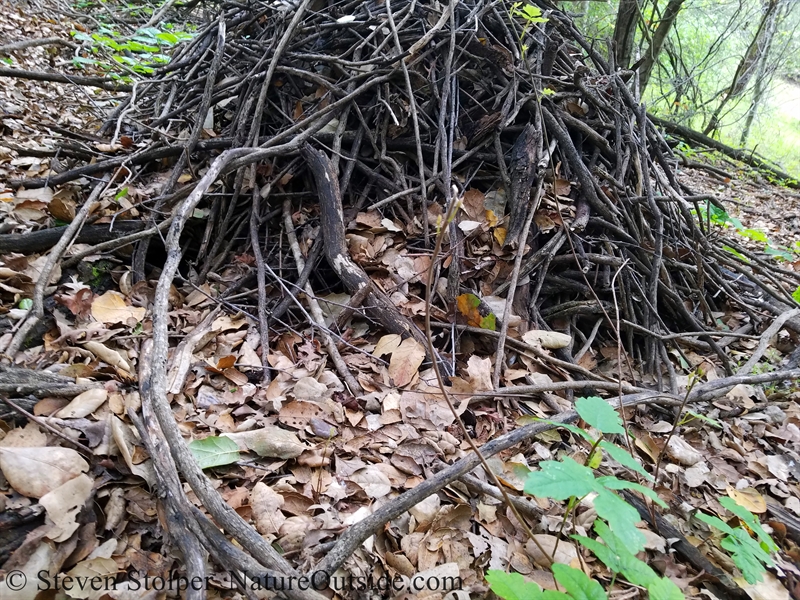
A woodrat nest may have as many as six entrances.
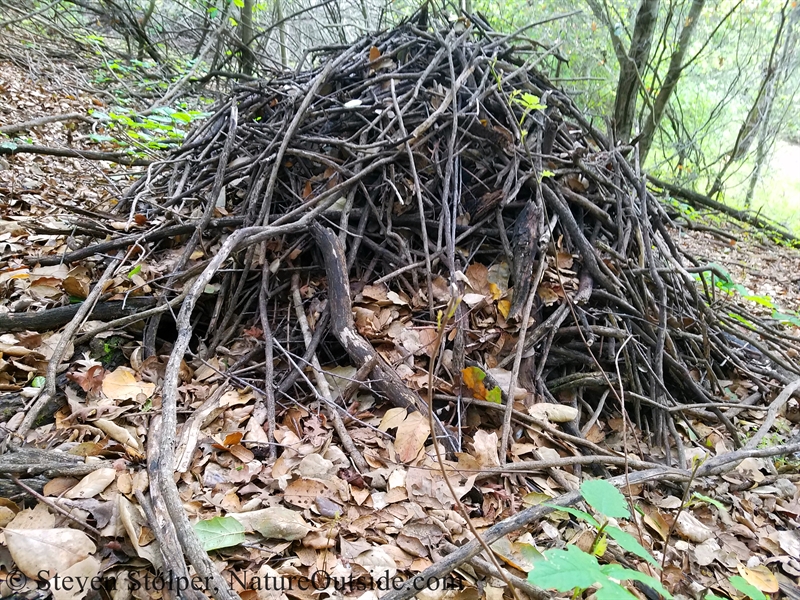
A woodrat nest is a marvel of rodent engineering.
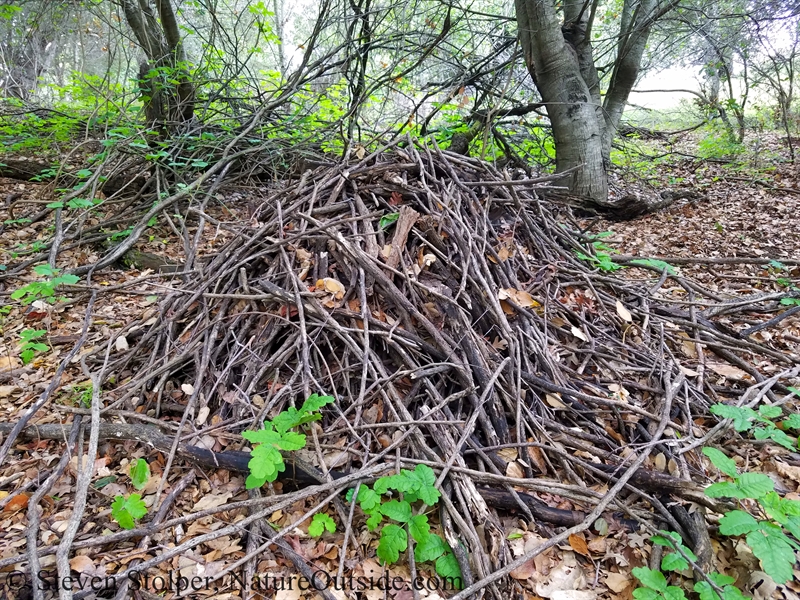
A “rear view” of the nest.
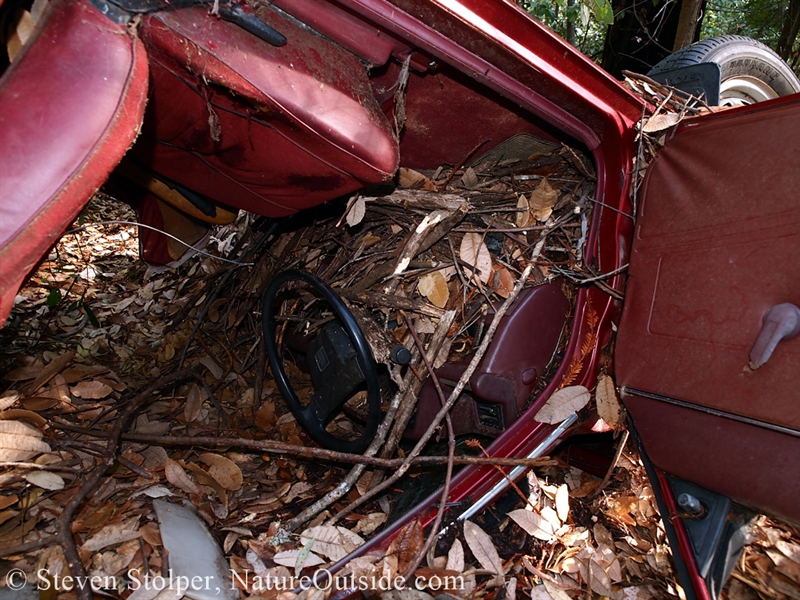
A woodrat nest built inside an abandoned car at the bottom of a ravine (Photo by K. Leal)
Woodrats are good landlords. Rabbit, mice, snakes, tree frogs, toads, and lizards sometimes take up house with woodrats. Skunk, opossum, and bobcat use abandoned woodrat nests as resting places during the day. A friend once related how he and a buddy found a woodrat nest while hiking. For absolutely no reason, he leapt atop the nest. An ear-shrieking howl scared the wits out of him as a bobcat dashed from inside the nest. Fortunately, the bobcat was unharmed.
There are other inhabitants of woodrat nests that aren’t so cuddly. Ticks, fleas, and parasites also live among the sticks. Blood sucking assassin bugs (triatoma sp.) can communicate Chagas’ disease, which can be fatal in humans if untreated. The probability is low that you will be infected with the disease. But my philosophy is not to come into physical contact with woodrat nests if I can avoid it.
Dusky-footed woodrats near me line their nests with leaves from the California Bay Laurel. The oil in these leaves repels insects and parasites. The indigenous Ohlone peoples used the leaves for the same purpose in their acorn granaries.
When you see a woodrat nest, keep an eye out for others. Maternal neighborhoods often spring up as offspring disperse nearby.
Engineering and Architecture
Next time you’re out hiking, keep an eye out for woodrat nests. It is truly amazing that a rodent can build such a complex structure.
Have you seen them on your hikes? Let me know in the comments below.
References
1. Peterson Reference Guide to the Behavior of North American Mammals (Peterson Reference Guides)
Related Article on NatureOutside
It’s Enormous and it’s Coming Toward You! How to interpret Squirrel Alarm Calls (Audio)
Hike to Skeleton Grove (Part 1)
For fun facts and useful tips, join the free Bushcraft Newsletter.



I have been seeing these and photographing them on my hikes in the bay area over the past year. They are fascinating! I loved reading your article. Thank you so much for the wonderful information about these amazing creatures 🙂
You’re welcome, Alisa! It’s great that you have been noticing them and had the curiosity to learn what they are.
We have one at the bottom of our property in inland San Diego County. I was puzzled about who built it. That you for solving that for me. This was a great article.
Blair, I’m happy you solved your mystery!
Saw them for the first time today in Pt. Reyes. Shocked to find out they are built by rats, even large ones because the ones I saw were huge. I did see several in the same area so definitely a “neighborhood.” Most of the ones I saw were freestanding and completely visible from the trail. Thanks for the info!
You’re welcome, Margaret!
Woodrats are not “bro-dents,’ had me laughing out loud!! Thank you for the informative and lively article (: (saw a beautiful woodrat’s nest today on a hike near Monterey) Amazing Nature!
Bree, I’m happy you enjoyed the article. I expect that if you keep your eyes peeled you will spot a lot of them going forward.
I’ve loved seeing them for years, but horrifying and typical that that man jumped on top of one, clearly not caring if he killed anyone inside. I was just remembering how men even on docent-let hikes to see tarantulas then threw rocks at them or poked them with sticks. It’s clear who is the most dangerous species…
Hi Bev!
There is no doubt of who is the most dangerous species. That’s why it is up to us to educate (constructively) as many people as we can. Often people don’t think about what they’re doing. I would like to believe that the majority of these people would reconsider their actions if they gave them some thought.
Thanks, Steve! Unfortunately, I do think that girls and women do know to not torture or harm animals, males know but still do. (It was after hour-long talks about tarantulas that when the docent led us to search for them, men deliberately terrorized them with yelling, poking with sticks, throwing rocks. Amazing really, the lack of caring or shame. (A naturalist told me that those most likely to be bitten by rattlesnakes are males aged 18 to 22, drunk, bitten on their tongues.)
But thank you for this wonderful information about Woodrats! Rodents are so amazing. True rats will die for those they love and die from grief if someone they love dies. California Ground Squirrels, like cousin Prairie Dogs, have language with specific words for predator species that their sentries call out to warn their community.
I wish I knew if these smelled as good at rats, who smell like warm corn tortillas or spice cookies….
I have hiked in Laurelwood Park in San Mateo for years, but was recently joined for the first time by a long-time friend, and she – the observant one – noticed the woodrat nests that I had never seen. They seem to cluster under the live oaks that are plentiful in the park, and we saw many of them as we hiked up onto Sugarloaf Mountain, which forms the center of the park. Nice to add another critter to the list of live things with whom we share the park.
Thanks for your comment Janet! Knowing our animal and plant neighbors helps us better understand (and protect) the wilderness around us. Stay curious!
How can you get rid of them when they are near your property?
Cindy, thank you for your comment. I do not know how to get rid of them.
We live in Scotts Valley, Santa Cruz Mountains and we go hiking on East Glenwood Preserve frequently. We have seen numerous nests all over the place and only recently learned they are the homes of woodrats. We love this article! So much good information. Thank you!
You’re welcome, Emily! Woodrats really are amazing creatures, when we stop to consider them.